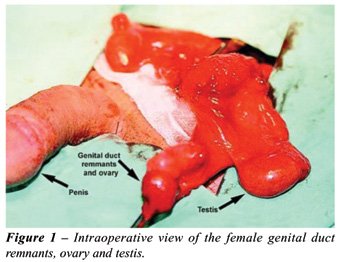TRUE
HERMAPHRODITISM PRESENTING AS AN INGUINAL HERNIA
(
Download pdf )
KADIR CEYLAN, EKREM ALGUN, MUSTAFA GUNES, HASAN GONULALAN
Yuzuncu Yil University, Faculty of Medicine, Departments of Urology and Endocrinology, Van, Turkey
ABSTRACT
A 21-year-old patient with cryptorchidism was found to have a left inguinal mass on physical examination. The patient was operated with a diagnosis of bilateral cryptorchidism and left inguinal hernia. Besides bilateral inguinal undescended testicles, female genital organs like fallopian tubes, uterus and ovary were found on the exploration.
Key
words: cryptorchidism; inguinal hernia; urogenital abnormalities;
true hermaphroditism
Int Braz J Urol. 2007; 33: 72-3
INTRODUCTION
In true hermaphroditism, both ovarian and testicular tissues are present in one or both gonads. Differentiation of the internal and external genitalia is highly variable. The external genitalia may simulate those of a male or female, but most often, they are ambiguous (1). The incidence is unknown, but more than 400 cases have been reported to this date. To justify the diagnosis, there must be histological documentation of both types of gonadal epithelium (2). The condition is usually diagnosed in the first few years of life (3). Here, we report a patient who first presented with bilateral cryptorchidism and left inguinal hernia when he was 21 years old.
CASE REPORT
A
21-year-old male patient presented with bilateral cryptorchidism and a
mass in the left inguinal canal. He had a male phenotype with fully developed
secondary sex characteristics. There were no hypospadias, gynecomastia
or any other somatic anomaly. He presented normal morning erection and
ejaculation and no history of urethral bleeding. Testes were palpable
on physical examination in the inguinal canal. Ultrasound examination
revealed bilateral cryptorchidism and left inguinal hernia. Serum testosterone,
LH and FSH levels were within normal limits for an adult male and he had
azoospermia on semen analysis. He was operated with a diagnosis of bilateral
cryptorchidism and left inguinal hernia. On inguinal exploration bilateral
cryptorchidism and uterus were found as well as fallopian tubes and ovary
on the left inguinal canal. Thus, there were 3 separate gonads: one testis
in the right side and one testis plus one ovary in the left side. Right
testis orchiopexy was performed. Left testis and the female genital duct
remnants were excised (Figure-1). Pathological examination of the testicular
specimen revealed germinal aplasia of the testicular tissue. Unfortunately,
karyotype analysis could not be performed for technical insufficiency.

COMMENTS
True
hermaphroditism is a phenotypically and genetically an heterogeneous condition.
Gonadal tissue may be located at any level along the route of embryonic
testicular descent and is frequently associated with an inguinal hernia.
There may be unilateral or bilateral ovotestis or a testis on one side
and ovary on the other side. A uterus is usually present, though it may
be hypoplastic or unicornous (1-4). Our case had testis on the right side
and a testis and female genital structures on the left side. Ovarian tissue
was dysgenetic and testicular tissue showed germinal aplasia.
In true hermaphroditism, the degree of virilisation
of the external genitalia depends on the capacity of testicular tissue
to secrete testosterone and the presence or absence of a uterus and tubes.
Although approximately 70% of true hermaphrodites are raised as males,
less than 10% have normal male external genitalia (1,2). Our case had
completely normal external genitalia except for cryptorchidism, moreover,
the patient had fully developed secondary sexual characteristics and defined
erections and ejaculations.
Most of the true hermaphrodites have ambiguous
genitalia and are diagnosed in the first few months to years of their
life (3). Our case is unique because there is no diagnosis during the
first 21 years of his life.
True hermaphroditism should also be considered
in the differential diagnosis of cryptorchidism and inguinal hernia in
a patient in the second or third decade.
CONFLICT OF INTEREST
None declared.
REFERENCES
- Conte FA, Grumbach MM: Abnormalities of Sexual Determination and Differentiation. In: Tanagho EA, McAninch JW (eds.), Smith’s General Urology. International Edition, 15th ed., New York, McGraw-Hill. 2000; pp. 699-736.
- Griffin JE, Wilson JD: Disorders of Sexual Differentiation. In: Walsh PC, Retik BA, Stamey TA, Vaughan DE (eds.), Campbell’s Urology. Philadelphia, WB Saunders. 1992; pp. 1509-42.
- Hadjiathanasiou CG, Brauner R, Lortat-Jacob S, Nivot S, Jaubert F, Fellous M, et al.: True hermaphroditism: genetic variants and clinical management. J Pediatr. 1994; 125: 738-44.
- Diamond DA: Sexual Differentiation: Normal and Abnormal. In: Walsh PC, Retik BA, Vaughan DE, Wein AJ (eds.), Campbell’s Urology. Philadelphia, WB Saunders. 2002; pp. 2395-427.
____________________
Accepted after revision:
October 15, 2006
_______________________
Correspondence address:
Dr. Kadir Ceylan
Yüzüncü Yil Universitesi
Tip Fakültesi
Uroloji Anabilim Dali
Van, Turkey
E-mail: drceylan26@yahoo.com